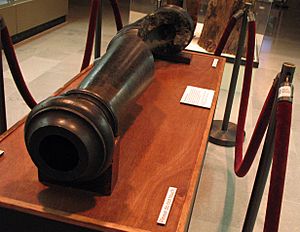Franklin's Fort facts for kids
Quick facts for kids Franklin's fort |
|
|---|---|
| Franklin (Douglas County), Kansas | |
| Coordinates | 38°56′02″N 95°10′34″W / 38.9338°N 95.1761°W |
| Type | prosouthern post during Bleeding Kansas era |
| Site information | |
| Controlled by | Pro-slavery partisans |
| Site history | |
| Built | May 1856 |
| In use | May to August 1856 |
| Garrison information | |
| Past commanders |
Sheriff Samuel J. Jones |
| Garrison | Pro-slavery partisans |
Franklin's Fort was a small fort built by settlers who supported slavery in Franklin, Douglas County, Kansas. It was an important spot during a tough time in Kansas history called "Bleeding Kansas." This fort saw two small battles between groups who supported slavery and those who were against it.
Contents
A Look Back: Why Franklin's Fort Was Built
Kansas: A Territory Divided
Franklin was a small town started in 1854. It was in Douglas County, part of the Kansas Territory. Most settlers here came from the southern United States. They wanted Kansas to join the country as a state where slavery was allowed.
Franklin: A Center for Slavery Supporters
By late 1855, Franklin had about a dozen homes and shops. It also had its own post office. The town quickly became a key place for people who supported slavery in Kansas.
Building the Fort
In May 1856, a strong building called a blockhouse was put up in Franklin. This blockhouse was used to keep weapons safe. It also held a special cannon called the "Old Sacramento Cannon." This cannon had been taken during a raid on an army storage place in Liberty, Missouri. The blockhouse was built to protect Franklin from attacks, especially from people in the nearby town of Lawrence.
Battles at Franklin's Fort
First Battle: A Surprise Attack
Franklin's Fort was attacked twice in the summer of 1856. The first attack happened on June 4. About 15 members of the Lawrence Stubbs, a group against slavery from Lawrence, entered Franklin after dark. They were looking for the "Old Sacramento Cannon." This cannon had been taken from Lawrence during an earlier raid by slavery supporters.
Some defenders at the fort woke up when they heard noises. This started what is known as the First Battle of Franklin. The cannon was fired once, but it didn't hit anyone from the anti-slavery group. Town residents also shot from their houses at the attackers. This forced the anti-slavery group to leave. One man from Franklin was killed, and a few people were hurt. Some Franklin men might have been captured by the Lawrence group.
Second Battle: Fighting in the Dark
After the first battle, Franklin's Fort was made even stronger. On August 12, the Second Battle of Franklin took place. At least 75 men, possibly two groups, left Lawrence after dark. Their goal was to capture or destroy the fort. A leader of the anti-slavery movement, James H. Lane, led the march on Franklin.
Only about 20 men were defending Franklin and the fort. For several hours, the battle went on with both sides shooting in the dark. Not much damage was done at first. However, one anti-slavery fighter was killed, and several were wounded. One of the fort's defenders was also hurt.
The Cannon is Captured
A man from Franklin was sent to get help from a U.S. cavalry group. They were camped about 5 miles (8 km) away. The cavalry arrived just before sunrise, but by then the battle was over. The fort's defenders fought hard. But the Lawrence men finally made progress. They set a wagon full of hay on fire and pushed it to the fort's front door. The heat and light made the defenders think they would burn alive. They escaped into the night.
The nearby post office was damaged by fire during this battle. But the fort itself was only damaged by bullets. The anti-slavery fighters went inside the fort. They took 50 to 80 muskets and a lot of ammunition. They also found the "Old Sacramento Cannon." It was hidden to look like a dress-making mannequin. They took the food stored there and captured 14 prisoners. The anti-slavery group had one man killed and several wounded. The fort was left standing, but it was no longer used to defend the town. It was later turned into a home. Dr. R. L. Williams lived there until about the 1870s.


